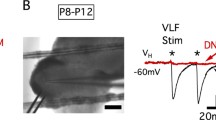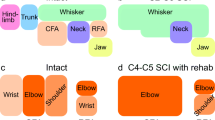Abstract
It had been shown previously that, following spinalization of the neonatal rat on postnatal day 7 (PN7), at the middle thoracic level, there was spontaneous recovery of coordinated stepping in the hindlimbs, enabling the animal to execute quadrupedal locomotion, with an ataxic gait. No significant recovery occurred in rats that were similarly spinalized on PN14. Despite the functional recovery in the PN7 group, their hindlimbs were paralyzed when not in contact with a surface. In the present experiments, at 16–18 weeks after spinalization, muscle spindle GpIa and cutaneous afferents were tested for functional connectivity to the alpha motoneurons (a-MNs) that innervate the right triceps surae (TS) muscles. The Hoffmann reflex (H-reflex), the tonic stretch reflex (TSR), and cutaneous reflexes were recorded from the right TS muscles in the nonanesthetized, intercollicular decerebrate preparation. The H-reflex and the TSR were readily elicited from the PN7 animals, but not from the PN14 animals. The PN14 preparations were characterized by prolonged (> 18 h in 3/8 cases), spontaneous discharge of motor units, and prominent M responses. There was widespread, bilateral convergence of cutaneous afferents from the hindquarters to the a-MNs of the TS muscles in both the PN7 and the PN14 preparations. In the nonspinalized, control preparation, only ipsilateral, cutaneous afferents activated the right TS a-MNs. These results demonstrate that in the chronic (> 3 months after spinalization), spinalized PN7 rat, but not in the PN14 rat, there is a tight functional connectivity between the hindlimb GpIa afferents and their homonymous a-MNs.
Similar content being viewed by others
References
Anderson O, Grillner S, Lindquist M, Zomlefer M (1978) Peripheral control of the spinal pattern generators for locomotion in cat. Brain Res 150:625–630
Aoki M, Watanabe H, Ebata N, Mori S (1978) Spontaneous respiratory activity in spinal cats. Brain Res 157:376–380
Appelberg B, Hulliger M, Johansson H, Sojka P (1983a) Actions on g-motoneurons elicited by electrical stimulation of Group I muscle afferent fibres in the hind limb of the cat. J Physiol (Lond) 335:237–253
Appelberg B, Hulliger M, Johansson H, Sojka P (1983b) Actions on g-motoneurons elicited by electrical stimulation of group III muscle afferents in the hind limb of the cat. J Physiol (Lond)335:275–292
Barbeau H, Rossignol S (1987) Recovery of locomotion after chronic spinalization in the adult cat. Brain Res 412:85–95
Barbeau H, Rossignol S (1990) The effects of serotonergic drugs on the locomotor pattern and on cutaneous reflexes of the adult chronic spinal cat. Brain Res 514:55–67
Cazalets JR, Sqalli-Houssini Y, Clarac F (1992) Activation of the central pattern generators for locomotion by serotonin and excitatory amino acids in neonatal rat. J Physiol (Lond) 455:189–204
Coglianese CJ, Peiss CN, Wurster RD (1977) Rhythmic phrenic nerve activity and respiratory activity in the spinal dog. Respir Physiol 29:247–54
Commissiong JW (1981) Spinal monoaminergic systems: an aspect of somatic motor function. Fed Proc 40:2771–2777
Commissiong JW (1983a) The development of catecholaminergic nerves in the spinal cord of the rat. Brain Res 264:197–208
Commissiong JW (1983b) The development of catecholaminergic nerves in the spinal cord of the rat. II. Regional development. Brain Res Dev 11:75–92
Commissiong JW (1991) The role of GpIa and cutaneous afferents in activating the lumbosacral central pattern generator. Soc Neurosci Abstr 17:197
Commissiong JW, Sedgwick ME (1974) A pharmacological study of the adrenergic mechanisms involved in the stretch reflex of the decerebrate rat. Br J Pharmacol 50:365–374
Commissiong JW, Sedgwick EM (1979) Modulation of the tonic stretch reflex by monoamines. Eur J Pharmacol 57:83–92
Commissiong JW, Toffano G (1989) Complete spinal cord transection at different postnatal ages: recovery of motor coordination correlated with spinal cord catecholamines. Exp Brain Res 78:597–603
Commissiong JW, Sauve Y, Csonka K, Karoum F, Toffano G (1991) Recovery of function in spinalized, neonatal rats. Brain Res Bull 27:1–4
Deliagina TG, Orlovsky GN, Pavlova GA (1983) The capacity for generation of rhythmic oscillations is distributed in the lumbosacral spinal cord of the cat. Exp Brain Res 53:81–90
Duysens J (1977) Reflex control of locomotion as revealed by stimulation of cutaneous afferents in spontaneously walking premammillary cats. J Neurophysiol 30:737–751
Edgerton VR, Guzman CP de, Gregor RJ, Roy RR, Hodgson JA, Lovely RG (1991) Trainability of the spinal cord to generate hindlimb stepping patterns in adult spinalized cat. In: Shimamura M, Grillner S, Edgerton VR (eds) Neurobiological basis of human locomotion. Springer, Berlin Heidelberg New York, pp 411–423
Eichenberger A, Ruegg DG (1984) Relation between the specific H-reflex facilitation preceding a voluntary movement and movement parameters in man. J Physiol (Lond) 347:545–559
Eidelberg E, Nguyen LH, Polich R, Walden JG (1989) Transsynaptic degeneration of motoneurons caudal to spinal cord lesions. Brain Res Bull 22:39–45
Godderz W, Illert M, Yamaguchi T (1990) Efferent pattern of fictive locomotion in the cat forelimb: with special reference to radial motor nuclei. Eur J Neurosci 2:663–671
Grillner S (1975) Locomotion in vertebrates: central mechanisms and reflex interactions. J Physiol (Lond) 55:247–304
Grillner S, Matsushima T (1991) The neural network underlying locomotion in lamprey: synaptic and cellular mechanisms. Neuron 7:1–15
Grillner S, Zangger P (1979) On the central generation of locomotion in the low spinal cat. Exp Brain Res 34:241–261
Hashimoto T, Fukuda N (1991) Contribution of serotonin neurons to the functional recovery after spinal cord injury in rats. Brain Res 539:263–270
Hernandez P, Elbert K, Droge MH (1991) Spontaneous and NMDA evoked motor rhythms in the neonatal mouse spinal cord: an in vitro study with comparisons to in situ activity. Exp Brain Res 85:66–74
Hultborn H, Meunier S, Morin C, Pierrot-Deseilligny E (1987) Assessing changes in presynaptic inhibition of Ia fibres: a study in man and in the cat. J Physiol (Lond) 389:729–756
Iwahara T, Atsuta Y, Garcia-Rill E, Skinner RD (1991) Locomotion induced by spinal cord stimulation in the neonate rat in vitro. Somatosens Mot Res 8:281–287
Johanson H, Sojka P (1985) Actions of g-motoneurons elicited by electrical stimulation of cutaneous afferent fibres in the hindlimb of the cat. J Physiol (Lond) 366:343–363
Kato M (1990) Chronically isolated lumbar half spinal cord generates locomotor activities in the ipsilateral hindlimb of the cat. Neurosci Res 9:22–34
Landau WM, Clare MH (1964) Fusimotor function. IV. Reinforcement of the H-reflex in normal subjects. Arch Neurol 10:117–122
Lennard PR, Stein SG (1977) Swimming movements elicited by electrical stimulation of the turtle spinal cord. I. Low spinal and intact preparations. J Neurophysiol 40:768–778
Lovely RG, Gregor RJ, Roy RR, Edgerton VR (1986) Effects of training on the effects of full-weight-bearing stepping in the adult spinal cat. Exp Neurol 92:421–435
McBride RL, Feringa ER (1992) Ventral horn motoneurons 10, 20 and 52 weeks after T-9 spinal cord transection. Brain Res Bull 28:57–60
Smith J, Feldman J, Schmidt B (1988) Neural mechanisms generating locomotion studied in mammalian brain stem-spinal cord in vitro. FASEB J 2:2283–2288
Stelzner DJ, Ershler WB, Weber ED (1975) Effects of spinal cord transection in neonatal and weanling rats: survival and function. Exp Neurol 46:156–177
Veale JL, Rees S (1973) Renshaw cell activity in man. J Neurol Neurosurg Psychiatry 36:674–683
Weber ED, Stelzner DJ (1977) Behavioural effects of spinal cord transection in the developing rat. Brain Res 125:241–255
Yakovleff A, Roby-Brami A, Guezard B, Mansour H, Bussel B, Privat A (1989) Locomotion in rats transplanted with noradrenergic neurons. Brain Res Bull 22:115–121
Author information
Authors and Affiliations
Rights and permissions
About this article
Cite this article
Commissiong, J.W., Sauve, Y. Neurophysiological basis of functional recovery in the neonatal spinalized rat. Exp Brain Res 96, 473–479 (1993). https://doi.org/10.1007/BF00234114
Received:
Accepted:
Issue Date:
DOI: https://doi.org/10.1007/BF00234114




